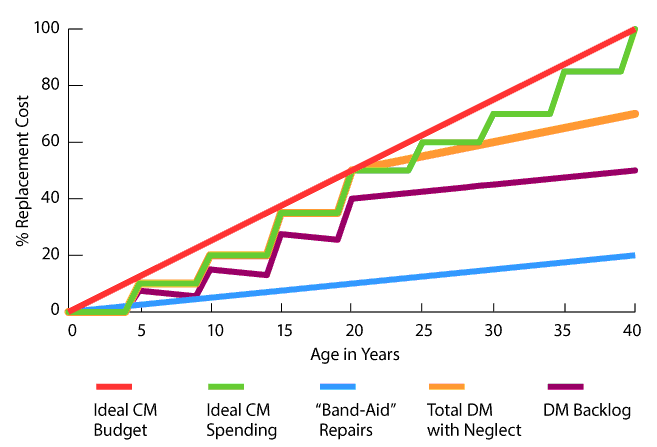These randomly scheduled missives will opine on a variety of topics, mostly intended to be germane to design, construction, capital program management, and other related issues. For shorter trips through the countryside, take a look at our blog, also called Notes from the Road. |
|
January 2013 A Swamp Full of Alligators
Alright, the analogy may be tortured; but the emotions of the situation relate to those of a building owner or facilities manager who finally comprehends that years of neglect must be reversed. How can this be? We all know what the yearly set-aside should be for a building’s Capital Maintenance: Yearly Budget = Capital Replacement Value ÷ Asset Financial Life in YearsIf this seems unfamiliar, take a gander at the newsletter co-authored with my colleague Mort Engstrom Plan to Live Forever! But, what if all you’ve done for years is patch your buildings with Band-Aids and chewing gum? What is the accumulated Deferred Maintenance and what are the appropriate set-asides going forward? Maybe this chart for a building with a 40-year Financial Life will help the discussion:
I’ll explain the legend. Ideal CM (Capital Maintenance) BudgetThe prudent amount to set aside to stay abreast of Capital Maintenance “Band-Aid” RepairsThe amount expended when building maintenance is addressed only when failure of a component or system forces action. Ideal CM (Capital Maintenance) SpendingThe effort to maintain buildings is usually periodic. For example, roofs may be replaced every 20 years, and water heaters every 10 years. Consequently, the chart line is “jumpy”, and a stylized version is shown. DM (Deferred Maintenance) BacklogDeferred Maintenance is “Capital Maintenance that was not done when it should have”. If you’re lucky as shown here, it’s the difference between the Ideal CM Spending and what was spent on Band-Aid repairs. If you’re unlucky, damages that are more serious have occurred, and the amounts may be higher. Total DM (Deferred Maintenance) with NeglectThis line is hypothetical, but informative. It shows what may happen over time, if you have no real Capital Maintenance plan, and all you do is address emergencies. At some point in the mid-life of the building, the systems that have not been addressed may finally get restored. If you limped past a few system cycles, it’s not required to “start from scratch” to catch up. For example, the 20 year old water heater that should have been replaced when it was 10 years old gets replaced once, not twice. A “New” Perspective
The principal benefit of a good Condition Assessment for our charting is that it takes the guesswork out of properly placing the Deferred Maintenance line. The obligation to correctly plan for the future, and extrapolate expenditures, remains unaltered. Benign Neglect Is Not a Good Thing
The principal argument against the “neglect” approach, however, is that the building never functions as intended. All of the planned building uses are diminished, sometimes with measurable financial consequences. Even when the principal harm is aesthetic, the core criticism is “you have failed to get what you paid for”; and sadly, you would only have yourself to blame for this result.
If you are determined to nitpick, I can’t stop you. What I’ve tried to portray, however, is a concept, where my intent is to instigate dialog. Details are fungible. Calamities, and other unforeseen events, will alter even the most finely tuned hypotheses. Squint your eyes when you look at the chart – OK? ARE YOU “DRAINED” YET? Alligators are fearsome creatures. I know, I was just two feet from one a few days ago – and I had no urge to pet it. Sometimes the responsibilities of Facilities Management can seem almost as intimidating. In both cases, cautious maneuvering can accommodate all parties. In our professional realm, buildings can be maintained, and expenditures can be cautiously monitored. Missed earlier newsletters? Find them here: October 2012 “Plan to Live Forever, Part Deux” |
|

 When you’re surrounded by alligators, it can be hard to remember that your objective is to drain the swamp.
When you’re surrounded by alligators, it can be hard to remember that your objective is to drain the swamp.
 Having participated in the sometimes-heated dialog between Facilities and Financial Managers, I have tried to see if there was a common ground between the two. In effect, the sample chart portrays a concession that many stalwart Facilities people have difficulty with: It may, in fact, be possible to reasonably address Deferred Maintenance without strictly reverting to the “Ideal” models that initial caution would have advised. Sure – if it’s broken, it should eventually be fixed. But, having done that, it doesn’t have to be fixed again –just maintained properly.
Having participated in the sometimes-heated dialog between Facilities and Financial Managers, I have tried to see if there was a common ground between the two. In effect, the sample chart portrays a concession that many stalwart Facilities people have difficulty with: It may, in fact, be possible to reasonably address Deferred Maintenance without strictly reverting to the “Ideal” models that initial caution would have advised. Sure – if it’s broken, it should eventually be fixed. But, having done that, it doesn’t have to be fixed again –just maintained properly. Admittedly, if one follows this “We’ll fix it when we have to” scenario I have outlined, there is the potential for less total Capital Maintenance expenditure. However, there is significant risk that this may not actually result. When systems fail, the failure might trigger other unplanned expenses. Emergency repair work may have to be done with overtime or after-hours labor, and cautious competitive bidding is seldom an option. In addition, failures of key systems routinely have collateral damage. The roof that finally failed in the thunderstorm will often cause water damage to other building systems, furnishings or equipment. Expenses to address such things still must be addressed, and they are often very substantial.
Admittedly, if one follows this “We’ll fix it when we have to” scenario I have outlined, there is the potential for less total Capital Maintenance expenditure. However, there is significant risk that this may not actually result. When systems fail, the failure might trigger other unplanned expenses. Emergency repair work may have to be done with overtime or after-hours labor, and cautious competitive bidding is seldom an option. In addition, failures of key systems routinely have collateral damage. The roof that finally failed in the thunderstorm will often cause water damage to other building systems, furnishings or equipment. Expenses to address such things still must be addressed, and they are often very substantial. OK – DISCLAIMER TIME
OK – DISCLAIMER TIME